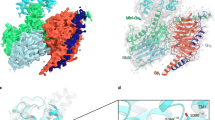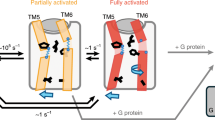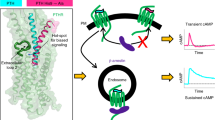Abstract
Many peptide hormones elicit a wide array of physiological effects by binding to G-protein coupled receptors. We have determined the conformation of pituitary adenylate cyclase activating polypeptide, PACAP(1–21)NH2, bound to a PACAP-specific receptor by NMR spectroscopy. Residues 3–7 form a unique β-coil structure that is preceded by an N-terminal extended tail. This β-coil creates a patch of hydrophobic residues that is important for receptor binding. In contrast, the C-terminal region (residues 8–21) forms an α-helix, similar to that in the micelle-bound PACAP. Thus, the conformational difference between PACAP in the receptor-bound and the micelle-bound states is limited to the N-terminal seven residues. This observation is consistent with the two-step ligand transportation model in which PACAP first binds to the membrane nonspecifically and then diffuses two-dimensionally in search of its receptor; a conformational change at the N-terminal region then allows specific interactions between the ligand and the receptor.
This is a preview of subscription content, access via your institution
Access options
Subscribe to this journal
Receive 12 print issues and online access
$189.00 per year
only $15.75 per issue
Buy this article
- Purchase on Springer Link
- Instant access to full article PDF
Prices may be subject to local taxes which are calculated during checkout




Similar content being viewed by others
Accession codes
References
Gether, U. & Kobilka, B.K. J. Biol. Chem. 273, 17979–17982 (1998).
Unger, V.M., Hargrave, P.A., Baldwin, J.M. & Schertler, G.F. Nature 389, 203–206 (1997).
Miyata, A. et al. Biochem. Biophys. Res. Commun. 164, 567–574 (1989).
Arimura, A. Jpn. J. Physiol. 48, 301–331 (1998).
Christophe, J. Biochim. Biophys. Acta. 1241, 45–57 (1995).
Inooka, H., Endo, S., Kitada, C., Mizuta, E. & Fujino, M. Int. J. Pept. Protein. Res. 40, 456–464 (1992).
Inooka, H., Endo, S., Kitada, C. & Mizuta, E. The conference abstract of the 31st NMR meeting. (Gakujutsusyuppan-insatsu, Ashiya, Hyougo, Japan) 305–308 (1992).
Wray, V., Kakoschke, C., Nokihara, K., Naruse, S. Biochemistry 32, 5832–5841 (1993).
Braun, W., Wider, G., Lee, K.H. & Wüthrich, K. J. Mol. Biol. 169, 921–948 (1983).
Gronenborn, A.M., Bovermann, G. & Clore, G.M. FEBS Lett. 215, 88–94 (1987).
Fry, D.C. et al. Biochemistry 28, 2399–2409 (1989).
Ohtaki, T. et al. J. Biol. Chem. 273, 15464–15473 (1998).
Ogi, K. et al. Biochem. Biophys. Res. Commun. 196, 1511–1521 (1993).
Clore, G.M. & Gronenborn, A.M. J. Magn. Reson. 48, 402–417 (1982).
Campbell, A.P. & Sykes, B.D. J. Magn. Reson. 93, 77–92 (1991).
Lippens, G.M., Cerf, C. & Hallenga, K. J. Magn. Reson. 99, 268–281 (1992).
London, R.E., Perlman, M.E. & Davis, D.G. J. Magn. Reson. 97, 79–98 (1992).
Davis, D.G., Perlman, M.E. & London, R.E. J. Magn. Reson. B 104, 266–275 (1994).
Wakamatsu, K. et al. Eur. J. Biochem. 163, 331–338 (1987).
Kusunoki, H., Wakamatsu, K., Sato, K., Miyazawa, T. & Kohno, T. Biochemistry 37, 4782–4790 (1998).
Brünger, A.T. X-PLOR 3.1: a system for X-ray crystallography and NMR (Yale University Press, New Haven, Connecticut; 1993).
Boelens, R., Koning, T.M.G., Van der Marel, G.A., Van Boom, J.H. & Kaptein, R. J. Magn. Reson. 82, 290–308 (1989).
Beswick, V. et al. Eur. Biophys. J. 28, 48–58 (1999).
Wüthrich, K. NMR of proteins and nucleic acids. (John Wiley & Sons, New York; 1986).
Robberecht, P. et al. Eur. J. Biochem. 207, 239–246 (1992).
Adam, G. & Delbueck, M. In Structural chemistry and molecular biology (eds Rich, A. & Davidson, N.) 198–215 (1968).
Warren, W.S., Richter, W., Andreotti, A.H. & Farmer, B.T. 2nd Science 262, 2005–2009 (1993).
Liu, M. et al. J. Magn. Reson. 132, 125–129 (1998).
Bonvin, A.M. et al. J. Mol. Biol. 236, 328–341 (1994).
Laskowski, R.A., Rullmannn, J.A., MacArthur, M.W., Kaptein, R. & Thornton, J.M. J. Biomol. NMR 8, 477–486 (1996).
Acknowledgements
We thank K. Wakamatsu, Y. Kyogoku, H. Akutsu, Y. Yamamoto and M. Waelchli for helpful discussions. This research was supported by the Ministry of Education, Science, Sports and Culture of Japan.
Author information
Authors and Affiliations
Corresponding authors
Rights and permissions
About this article
Cite this article
Inooka, H., Ohtaki, T., Kitahara, O. et al. Conformation of a peptide ligand bound to its G-protein coupled receptor. Nat Struct Mol Biol 8, 161–165 (2001). https://doi.org/10.1038/84159
Received:
Accepted:
Issue Date:
DOI: https://doi.org/10.1038/84159
This article is cited by
-
Structure of the agonist 12–HHT in its BLT2 receptor-bound state
Scientific Reports (2020)
-
GPCR drug discovery: integrating solution NMR data with crystal and cryo-EM structures
Nature Reviews Drug Discovery (2019)
-
High-resolution crystal structure of parathyroid hormone 1 receptor in complex with a peptide agonist
Nature Structural & Molecular Biology (2018)
-
Current understanding of the structure and function of family B GPCRs to design novel drugs
Hormones (2018)
-
Conformational states of the full-length glucagon receptor
Nature Communications (2015)



